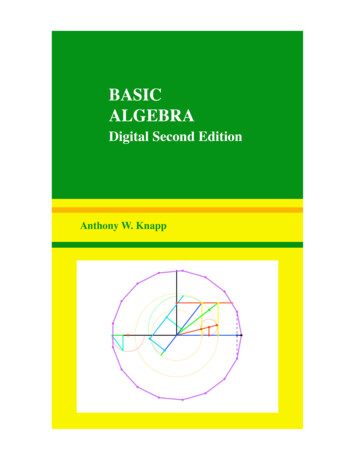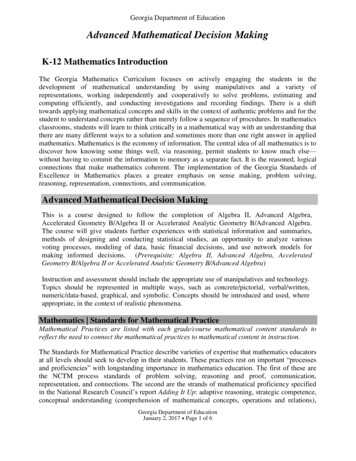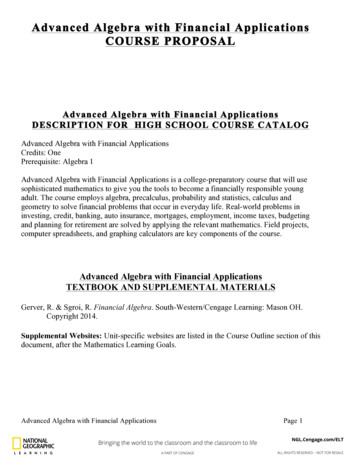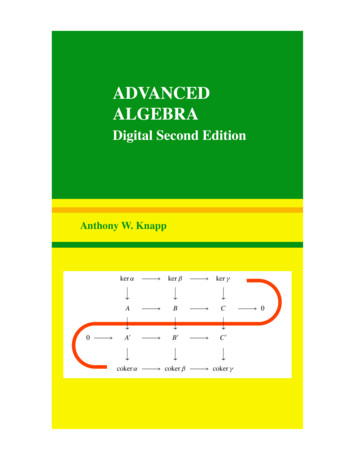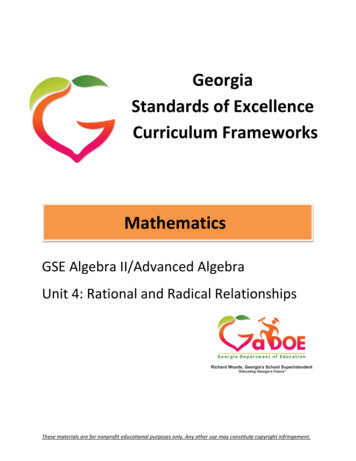
Transcription
GeorgiaStandards of ExcellenceCurriculum FrameworksMathematicsGSE Algebra II/Advanced AlgebraUnit 4: Rational and Radical RelationshipsThese materials are for nonprofit educational purposes only. Any other use may constitute copyright infringement.
Georgia Department of EducationGeorgia Standards of Excellence FrameworkGSE Algebra II/Advanced Algebra Unit 4Unit 4Rational and Radical RelationshipsTable of ContentsOVERVIEW . 3STANDARDS ADDRESSED IN THIS UNIT . 4ENDURING UNDERSTANDINGS . 6ESSENTIAL QUESTIONS . 6CONCEPTS/SKILLS TO MAINTAIN . 7SELECTED TERMS AND SYMBOLS . 7EVIDENCE OF LEARNING . 8SPOTLIGHT TASKS . 83-ACT TASKS. 9TASKS . 10Operations with Rational Expressions Task . 12Characteristics of Rational Functions Task . 20Horizontal Asymptotes: How do we find them? . 37Graphing Rational Functions Without a Calculator . 51Jogging into the Wind . 62Hank’s Hot Dog Stand . 69That’s Radical Dude . 75Let’s Get to “Work” . 84Sailing Into the Wind (Spotlight Task) . 92Extraneous Solutions . 99To Bracket or Not To Bracket . 104Culminating Task: NFL Passer Rating: Applications of Rational Functions . 108Culminating Task: Create A Can . 115Mathematics GSE Algebra II/Advanced Algebra Unit 4: Rational and Radical RelationshipsJuly 2019 Page 2 of 119All Rights Reserved
Georgia Department of EducationGeorgia Standards of Excellence FrameworkGSE Algebra II/Advanced Algebra Unit 4OVERVIEWIn this unit students will: Explore Rational and Radical Functions Determine rational numbers extend the arithmetic of integers by allowing division by allnumbers except zero. Similarly, rational expressions extend the arithmetic of polynomialsby allowing division by all polynomials except the zero polynomial Notice the arithmetic of rational expressions is governed by the same rules as thearithmetic of rational numbers Investigate the properties of simple rational and radical functions and then expand theirknowledge of the graphical behavior and characteristics of more complex rationalfunctions Recall and make use of their knowledge of polynomial functions as well as compositionsof functions to investigate the characteristics of these more complex rational functions Solve equations and inequalities involving rational and radical functions Understand that not all solutions generated algebraically are actually solutions to theequations and extraneous solutions will be explored Apply these rational and radical functions with an emphasis on interpretation of realworld phenomena as it relates to certain characteristics of the rational expressionsAlthough the units in this instructional framework emphasize key standards and big ideasat specific times of the year, routine topics such as estimation, mental computation, and basiccomputation facts should be addressed on an ongoing basis. Ideas related to the eight processstandards should be addressed constantly as well. To assure that this unit is taught with theappropriate emphasis, depth, and rigor, it is important that the tasks listed under “Evidence ofLearning” be reviewed early in the planning process. A variety of resources should be utilized tosupplement this unit. This unit provides much needed content information, but excellent learningactivities as well. The tasks in this unit illustrate the types of learning activities that should beutilized from a variety of sources.Mathematics GSE Algebra II/Advanced Algebra Unit 4: Rational and Radical RelationshipsJuly 2019 Page 3 of 119All Rights Reserved
Georgia Department of EducationGeorgia Standards of Excellence FrameworkGSE Algebra II/Advanced Algebra Unit 4STANDARDS ADDRESSED IN THIS UNITMathematical standards are interwoven and should be addressed throughout the year in as manydifferent units and activities as possible in order to emphasize the natural connections that existamong mathematical topics.KEY STANDARDSRewrite rational expressionsMGSE9-12.A.APR.7 Understand that rational expressions form a system analogous to therational numbers, closed under addition, subtraction, multiplication, and division by a nonzerorational expression; add, subtract, multiply, and divide rational expressions.Create equations that describe numbers or relationshipsMGSE9-12.A.CED.1 Create equations and inequalities in one variable and use them to solveproblems. Include equations arising from linear, quadratic, simple rational, and exponentialfunctions (integer inputs only).MGSE9-12.A.CED.2 Create linear, quadratic, and exponential equations in two or morevariables to represent relationships between quantities; graph equations on coordinate axes withlabels and scales. (Limit to rational and radical functions. The phrase “in two or morevariables” refers to formulas like the compound interest formula, in which A P(1 r/n)nt hasmultiple variables.)Understand solving equations as a process of reasoning and explain the reasoningMGSE9-12.A.REI.2 Solve simple rational and radical equations in one variable, and giveexamples showing how extraneous solutions may arise.Interpret functions that arise in applications in terms of the contextMGSE9-12.F.IF.4 Using tables, graphs, and verbal descriptions, interpret the key characteristicsof a function which models the relationship between two quantities. Sketch a graph showing keyfeatures including: intercepts; interval where the function is increasing, decreasing, positive, ornegative; relative maximums and minimums; symmetries; end behavior; and periodicity. (Limitto radical and rational functions.)MGSE9-12.F.IF.5 Relate the domain of a function to its graph and, where applicable, to thequantitative relationship it describes. For example, if the function h(n) gives the number ofMathematics GSE Algebra II/Advanced Algebra Unit 4: Rational and Radical RelationshipsJuly 2019 Page 4 of 119All Rights Reserved
Georgia Department of EducationGeorgia Standards of Excellence FrameworkGSE Algebra II/Advanced Algebra Unit 4person-hours it takes to assemble n engines in a factory, then the positive integers would be anappropriate domain for the function. (Limit to radical and rational functions.)Analyze functions using different representationsMGSE9-12.F.IF.7 Graph functions expressed algebraically and show key features of the graphboth by hand and by using technology. (Limit to radical and rational functions.)MGSE9-12.F.IF.7b Graph square root, cube root, and piecewise-defined functions,including step functions and absolute value functions.MGSE9-12.F.IF.7d Graph rational functions, identifying zeros and asymptotes whensuitable factorizations are available, and showing end behavior.RELATED STANDARDSMGSE9-12.A.SSE.1a Interpret parts of an expression, such as terms, factors, and coefficients, incontext.MGSE9-12.A.SSE.2 Use the structure of an expression to rewrite it in different equivalentforms. For example, see x4 – y4 as (x2)2 - (y2)2, thus recognizing it as a difference of squares thatcan be factored as (x2 – y2) (x2 y2).MGSE9-12.F.IF.9 Compare properties of two functions each represented in a different way(algebraically, graphically, numerically in tables, or by verbal descriptions). For example, givena graph of one function and an algebraic expression for another, say which has the largermaximum.Build a function that models a relationship between two quantitiesMGSE9-12.F.BF.1 Write a function that describes a relationship between two quantities.MGSE9-12.F.BF.1a Determine an explicit expression and the recursive process (steps forcalculation) from context. For example, if Jimmy starts out with 15 and earns 2 a day, theexplicit expression “2x 15” can be described recursively (either in writing or verbally) as “ tofind out how much money Jimmy will have tomorrow, you add 2 to his total today.” 𝐽𝑛 𝐽𝑛 1 2, 𝐽0 15Mathematics GSE Algebra II/Advanced Algebra Unit 4: Rational and Radical RelationshipsJuly 2019 Page 5 of 119All Rights Reserved
Georgia Department of EducationGeorgia Standards of Excellence FrameworkGSE Algebra II/Advanced Algebra Unit 4STANDARDS FOR MATHEMATICAL PRACTICERefer to the Comprehensive Course Overview for more detailed information about theStandards for Mathematical Practice.1. Make sense of problems and persevere in solving them.2. Reason abstractly and quantitatively.3. Construct viable arguments and critique the reasoning of others.4. Model with mathematics.5. Use appropriate tools strategically.6. Attend to precision.7. Look for and make use of structure.8. Look for and express regularity in repeated reasoning.ENDURING UNDERSTANDINGS Recognize rational functions as the division of two polynomial functions and rewrite arational expressionFind the sum, difference, product, and quotient of rational expressionsGraph rational and radical functionsInterpret graphs and discover characteristics of rational functionsSolve rational and radical equations algebraically and graphicallySolve rational inequalitiesESSENTIAL QUESTIONS How can we extend arithmetic properties and processes to algebraic expressions and howcan we use these properties and processes to solve problems?How do the polynomial pieces of a rational function affect the characteristics of thefunction itself?How are horizontal asymptotes, slant asymptotes, and vertical asymptotes alike anddifferent?Mathematics GSE Algebra II/Advanced Algebra Unit 4: Rational and Radical RelationshipsJuly 2019 Page 6 of 119All Rights Reserved
Georgia Department of EducationGeorgia Standards of Excellence FrameworkGSE Algebra II/Advanced Algebra Unit 4 Why are all solutions not necessarily the solution to an equation? How can you identifythese extra solutions?Why is it important to set a rational inequality to 0 before solving?CONCEPTS/SKILLS TO MAINTAINIt is expected that students will have prior knowledge/experience related to the concepts andskills identified below. It may be necessary to pre-assess in order to determine if time needs tobe spent on conceptual activities that help students develop a deeper understanding of theseideas. Computation with fractions Factoring polynomials Solving linear and quadratic equationsSELECTED TERMS AND SYMBOLSThe following terms and symbols are often misunderstood. These concepts are not aninclusive list and should not be taught in isolation. However, due to evidence of frequentdifficulty and misunderstanding associated with these concepts, instructors should pay particularattention to them and how their students are able to explain and apply them.The definitions below are for teacher reference only and are not to be memorizedby the students. Students should explore these concepts using models and real lifeexamples. Students should understand the concepts involved and be able to recognize and/ordemonstrate them with words, models, pictures, or numbers.The websites below are interactive and include a math glossary suitable for elementarychildren. Note – At the elementary level, different sources use different definitions. Pleasepreview any website for alignment to the definitions given in the maths/dictionary.htmlThis web site has activities to help students more fully understand and retain new omepg.aspDefinitions and activities for these and other terms can be found on the Intermath website. Algebra: The branch of mathematics that deals with relationships between numbers,utilizing letters and other symbols to represent specific sets of numbers, or to describe apattern of relationships between numbers. Coefficient: A number multiplied by a variable. Equation: A number sentence that contains an equality symbol.Mathematics GSE Algebra II/Advanced Algebra Unit 4: Rational and Radical RelationshipsJuly 2019 Page 7 of 119All Rights Reserved
Georgia Department of EducationGeorgia Standards of Excellence FrameworkGSE Algebra II/Advanced Algebra Unit 4 Expression: A mathematical phrase involving at least one variable and sometimesnumbers and operation symbols. Extraneous Solutions: A solution of the simplified form of the equation that does notsatisfy the original equation. Inequality: Any mathematical sentence that contains the symbols (greater than), (lessthan), (less than or equal to), or (greater than or equal to). Polynomial: A mathematical expression involving the sum of terms made up of variablesto nonnegative integer powers and real-valued coefficients. Radical Function: A function containing a root. The most common radical functions arethe square root and cube root functions, 𝑓(𝑥) 𝑥 𝑎𝑛𝑑 𝑔(𝑥) 3 𝑥 . Rational Function: The quotient of two polynomials, P(z) and Q(z), where 𝑅(𝑧) 𝑄(𝑧). Reciprocal: Two numbers whose product is one. For example, 𝑚 𝑥 Variable: A letter or symbol used to represent a number.𝑃(𝑧)1𝑚 1EVIDENCE OF LEARNINGBy the conclusion of this unit, students should be able to demonstrate the followingcompetencies: Rewrite rational expressions in different forms Add, subtract, multiply, and divide rational expressions Solve rational and radical equations Solve rational inequalities Graph rational and radical functions and identify key characteristics Interpret solutions to graphs and equations given the context of the problemSPOTLIGHT TASKSA Spotlight Task has been added to each GSE mathematics unit in the Georgia resources formiddle and high school. The Spotlight Tasks serve as exemplars for the use of the Standards forMathematical Practice, appropriate unit-level Georgia Standards of Excellence, and researchbased pedagogical strategies for instruction and engagement. Each task includes teachercommentary and support for classroom implementation. Some of the Spotlight Tasks arerevisions of existing Georgia tasks and some are newly created. Additionally, some of theSpotlight Tasks are 3-Act Tasks based on 3-Act Problems from Dan Meyer and Problem-BasedLearning from Robert Kaplinsky.Mathematics GSE Algebra II/Advanced Algebra Unit 4: Rational and Radical RelationshipsJuly 2019 Page 8 of 119All Rights Reserved
Georgia Department of EducationGeorgia Standards of Excellence FrameworkGSE Algebra II/Advanced Algebra Unit 43-ACT TASKSA Three-Act Task is a whole group mathematics task consisting of 3 distinct parts: an engagingand perplexing Act One, an information and solution seeking Act Two, and a solution discussionand solution revealing Act Three.More information along with guidelines for 3-Act Tasks may be found in the ComprehensiveCourse Overview.Mathematics GSE Algebra II/Advanced Algebra Unit 4: Rational and Radical RelationshipsJuly 2019 Page 9 of 119All Rights Reserved
Georgia Department of EducationGeorgia Standards of Excellence FrameworkGSE Algebra II/Advanced Algebra Unit 4TASKSThe following tasks represent the level of depth, rigor, and complexity expected of all AlgebraII/Advanced Algebra students. These tasks, or tasks of similar depth and rigor, should be used todemonstrate evidence of learning. It is important that all elements of a task be addressedthroughout the learning process so that students understand what is expected of them. Whilesome tasks are identified as a performance task, they may also be used for teaching and learning(learning/scaffolding task).Task NameOperations withRational ExpressionsTask TypeGrouping StrategyLearning TaskPartner/Small Group TaskAdd, subtract, multiply and divide rationalexpressionsCharacteristics ofRational FunctionsLearning TaskPartner/Small Group TaskInvestigating the characteristics of thegraphs of rational functionsHorizontalAsymptotes: How dowe find them?Graphing RationalFunctions Without aCalculatorJogging Into theWindLearning TaskPartner/Small Group TaskExploring end behavior in rationalfunctionsPerformance TaskIndividual/Partner TaskGraphing rational functions by handHank’s Hot DogStandPerformance TaskIndividual/Partner TaskThat’s Radical DudeLet’s Get to “Work”Learning TaskPartner/Small Group TaskPerformance TaskIndividual/Partner TaskSailing Into the Wind(Spotlight Task)Performance TaskIndividual/Partner TaskSimplifying radical expressionsExtraneous SolutionsLearning TaskPartner/Small Group TaskMore work with rational and radicalequations focusing on extraneous solutionsTo Bracket or Not toBracketLearning TaskPartner/Small Group TaskSolving rational inequalitiesLearning/PerformanceIndividual/Partner TaskContent AddressedConstructing functions that represent aquantity of interest in context. Interpretingfeatures of functions in light of a context.Interpret a simple rational function andrestrict its domain based on the context of aproblemGraphing square and cube rootsSolving and applying rational and radicalequationsMathematics GSE Algebra II/Advanced Algebra Unit 4: Rational and Radical RelationshipsJuly 2019 Page 10 of 119All Rights Reserved
Georgia Department of EducationGeorgia Standards of Excellence FrameworkGSE Algebra II/Advanced Algebra Unit 4Culminating Task:NFL Passer RatingPerformance TaskIndividual/Partner TaskReal life situation involving rationalequationsCulminating Task:Create-A-CanPerformance TaskIndividual/Partner TaskReal life situation involving rationalequations (alternative task)Mathematics GSE Algebra II/Advanced Algebra Unit 4: Rational and Radical RelationshipsJuly 2019 Page 11 of 119All Rights Reserved
Georgia Department of EducationGeorgia Standards of Excellence FrameworkGSE Algebra II/Advanced Algebra Unit 4Operations with Rational Expressions TaskBack to Task TableMath Goals Simplify rational expressions Add and subtract rational expressions Multiply and divide rational expressionsGeorgia Standards of ExcellenceMGSE9-12.A.APR.7 Understand that rational expressions form a system analogous to therational numbers, closed under addition, subtraction, multiplication, and division by a nonzerorational expression; add, subtract, multiply, and divide rational expressions.Standards for Mathematical Practice1. Attend to precision2. Look for and make use of structure3. Look for and express regularity in repeated reasoningIntroductionThis task allows students to discuss with a partner fraction operations in order to extend thoseideas to rational expressions. This task is just the introduction. Students need practice withvarious types of problems in order to become proficient with the skills introduced here. You canadd complexity by making the numerator and denominators harder to factor. Likewise, you canalso simplify the concepts for struggling learners by using polynomials that involve only simplefactoring.Operations with Rational ExpressionsThinking about operations with rational numbers, or fractions, will help us perform addition,subtraction, multiplication, and division with rational expressions. We will use examplesinvolving fractions to help us extend our thinking to dealing with fractions with variables, orrational expressions. Simplifying Rational ExpressionsThink about the fractionform?108210. What operation do we use to rewrite this fraction in simplestAnswers may vary, but you want students to realize that they use division to simplify afraction.What is the possible obstacle in using this operation to simplify fractions?Mathematics GSE Algebra II/Advanced Algebra Unit 4: Rational and Radical RelationshipsJuly 2019 Page 12 of 119All Rights Reserved
Georgia Department of EducationGeorgia Standards of Excellence FrameworkGSE Algebra II/Advanced Algebra Unit 4If a student chooses a number that is not the greatest common factor of the numerator anddenominator, then they will have to repeat the process multiple times.Let’s try to simplify another way. Find the prime factorization of the numerator anddenominator of the fraction above. Use this form of the numerator and denominator to quicklysimplify the fraction.𝑥 2 9Now let’s think about the fraction: 𝑥 2 7𝑥 12. How can we use the idea of prime factorization tohelp us simplify this rational expression?We want students to see that if we factor the numerator and denominator then we can easily𝒙 𝟑eliminate the common factors. Solution: 𝒙 𝟒4 𝑥Try this one: 𝑥 4 How can factoring help us simplify this rational expression?In this case, students need to see that factoring -1 from the numerator or the denominator willhelp them simplify the fraction since the numerator and denominator are opposites. Solution:-1. Multiplying and Dividing Rational ExpressionsWe now need to think about multiplying fractions. Take a minute to discuss with a partner howyou would solve the following problem. Try to find more than one way and show your resultsbelow:4 24 14 10Answers will vary. When the class shares out the various strategies make sure the examplesinclude simplifying the fractions before you multiply as well as simply multiplying straightacross and then simplifying the product.Which method from above do you think would be easiest to extend to multiplication of rationalexpressions? Why?Mathematics GSE Algebra II/Advanced Algebra Unit 4: Rational and Radical RelationshipsJuly 2019 Page 13 of 119All Rights Reserved
Georgia Department of EducationGeorgia Standards of Excellence FrameworkGSE Algebra II/Advanced Algebra Unit 4Students should indicate that simplifying first is easier. In order to extend this to polynomials,students will need to factor.Take a look at5𝑥 2𝑥 2 4 𝑥 210𝑥 3. Use your ideas from above to help you multiply these two fractions.Make sure that students factor each denominator and numerator completely before theyeliminate common factors. This is also a good time to remind students of the rules of𝟏exponents. Solution: 𝟐𝒙(𝒙 𝟐)Now try this one:3𝑥 6𝑥 2 9 4𝑥 126𝑥 2 12𝑥𝟐Solution: 𝒙(𝒙 𝟑)What if we change the fraction multiplication problem that we started with to a divisionproblem? Talk to your partner about how to solve the problem below:4 24 14 10Answers will vary, but you want to make sure that students eventually use the correctterminology for dividing fractions, “multiply by the reciprocal”.What is the one difference in solving a fraction division problem versus a fraction multiplicationproblem?They must multiply by the reciprocal of the second fraction before they can complete theproblem using the strategies that we developed for multiplication above.Apply that idea to this problem:4𝑥 88𝑥 𝑥 2 46𝑥 2𝟑𝒙Solution: 𝒙 𝟐Let’s try one more:𝑥 2 2𝑥 153𝑥 2 12𝑥𝑥 2 9 𝑥 2 4𝑥𝒙 𝟓Solution: 𝟑(𝒙 𝟑). It is important to point out to students that our goal is to completely simplifythe fraction so it is unnecessary to distribute the 3 in the denominator.Mathematics GSE Algebra II/Advanced Algebra Unit 4: Rational and Radical RelationshipsJuly 2019 Page 14 of 119All Rights Reserved
Georgia Department of EducationGeorgia Standards of Excellence FrameworkGSE Algebra II/Advanced Algebra Unit 4 Adding and Subtracting Rational ExpressionsThe idea of using the processes for operations with fractions to guide us as we operated withrational functions continues, but addition and subtraction may seem a little more involved. Justlike with fractions it is necessary to have common denominators in both rational expressions31before you can add or subtract. Think about the fraction addition problem 10 6 . What is theleast common denominator (LCD)?Solution: The LCD is 30.You might be able to quickly realize that 30 is the LCD, but why is it 30? Turn to your partnerand explain a couple of ways of finding a common denominator.Students might try to explain that the way to find a common denominator is to multiply thedenominators, but it should be pointed out that will not necessarily give you the least commondenominator (like the example above).When thinking about denominators like x 2 or x – 3 it becomes important to understand whatmakes a LCD. In the fraction problem above, you might have been able to say that 30 is theLCD because it is the smallest number that both 10 and 6 divide into, but how do you create thatnumber if it isn’t obvious? (Hint: Think about prime factorization.)It is important for students to realize that the least common denominator is the number thatcontains all the factors of the two denominators the least number of times. For example, theprime factorization of 10 is 2 5 and the prime factorization of 6 is 2 3 so 2 3 5 30 is theLCD.When dealing with rational expressions, factoring is key. You must find all of the factors ofeach denominator to know what the LCD should be. Let’s try some. Find the LCD for thefollowing problems:3𝑏a. 5𝑎 , 4𝑎2Solution: 𝟐𝟎𝒂𝟐b.4,3𝑥 5 𝑥 5Solution: (𝒙 𝟓)(𝒙 𝟓)c.2𝑥,𝑥 1𝑥 2 𝑥 2 3𝑥 10Solution: (𝒙 𝟐)(𝒙 𝟓)Mathematics GSE Algebra II/Advanced Algebra Unit 4: Rational and Radical RelationshipsJuly 2019 Page 15 of 119All Rights Reserved
Georgia Department of EducationGeorgia Standards of Excellence FrameworkGSE Algebra II/Advanced Algebra Unit 4d.75,𝑥 2𝑥 2 3𝑥Solution: 𝒙(𝟐𝒙 𝟑)e.𝑥 9,𝑥𝑥 2 8𝑥 16 𝑥 2 7𝑥 12Solution: (𝒙 𝟒)𝟐 (𝒙 𝟑)Once you find the LCD, you complete the operation just like you would with fractions. Trythese problems:32f. 𝑥 3 𝑥 3𝟓𝒙 𝟑Solution: (𝒙 𝟑)(𝑿 𝟑)g.6𝑥 7𝑥 2 42 𝑥 2𝟖𝑿 𝟏𝟏Solution: (𝑿 𝟐)(𝑿 𝟐)h.Solution:2𝑛 5𝑚3𝟓𝟎𝒎 𝟏𝟐𝒏𝟑𝟎𝒎𝟑6 8𝑎 4i.Solution:j.106𝑚23𝑎8𝟑𝒂𝟐 𝟔𝒂 𝟏𝟐𝟖(𝒂 𝟐)𝑥𝑥 2 5𝑥 6𝒐𝒓𝟑(𝒂𝟐 𝟐𝒂 𝟒)𝟖(𝒂 𝟐)2 𝑥 2 3𝑥 2𝒙𝟐 𝒙 𝟔𝒙 𝟑Solution: (𝒙 𝟏)(𝒙 𝟐)(𝒙 𝟑) (𝒙 𝟏)(𝒙 𝟑)It is important for students to see that the finalsolution requires more factoring in order to have simplest form.Mathematics GSE Algebra II/Advanced Algebra Unit 4: Rational and Radical RelationshipsJuly 2019 Page 16 of 119All Rights Reserved
Georgia Department of EducationGeorgia Standards of Excellence FrameworkGSE Algebra II/Advanced Algebra Unit 4Operations with Rational ExpressionsThinking about operations with rational numbers, or fractions, will help us perform addition,subtraction, multiplication, and division with rational expressions. We will use examplesinvolving fractions to help us extend our thinking to dealing with fractions with variables, orrational expressions. Simplifying Rational ExpressionsThink about the fractionform?108210. What operation do we use to rewrite this fraction in simplestWhat is the possible obstacle in using this operation to simplify fractions?Let’s try to simplify another way. Find the prime factorization of the numerator anddenominator of the fraction above. Use this form of the numerator and denominator to quicklysimplify the fraction.𝑥 2 9Now let’s think about the fraction: 𝑥 2 7𝑥 12. How can we use the idea of prime factorization tohelp us simplify this rational expression?4 𝑥Try this one: 𝑥 4 How can factoring help us simplify this rational expression? Multiplying and Dividing Rational ExpressionsWe now need to think about multiplying fractions. Take a minute to discuss with a partner howyou would solve the following problem. Try to find more than one way and show your resultsbelow:4 24 14 10Which method from above do you think would be easiest to extend to multiplication of rationalexpressions? Why?Mathematics GSE Algebra II/Advanced Algebra Unit 4: Rational and Radical RelationshipsJuly 2019 Page 17 of 119All Rights Reserved
Georgia Department of EducationGeorgia Standards of Excellence FrameworkGSE Algebra II/Advanced Algebra Unit 4Take a look at5𝑥 2𝑥 2 4 𝑥 210𝑥 33𝑥 6. Use your ideas from above to help you multiply these two fractions.4𝑥 12Now try this one: 𝑥 2 9 6𝑥 2 12𝑥What if we change the fraction multiplication problem that we started with to a divisionproblem? Talk to your partner about how to solve the problem below:4 24 14 10What is the one difference in solving a fraction division problem versus a fraction multiplicationproblem?Apply that idea to this problem:Let’s try one more: 𝑥 2 2𝑥 153𝑥 2 12𝑥4𝑥 88𝑥 𝑥 2 46𝑥 2𝑥 2 9 𝑥 2
Georgia Department of Education Georgia Standards of Excellence Framework GSE Algebra II/Advanced Algebra Unit 4 Mathematics GSE Algebra II/Advanced Algebra Unit 4: R

